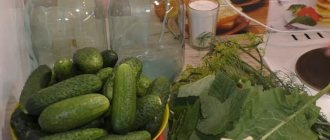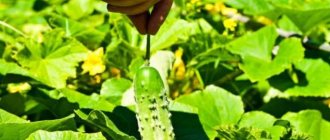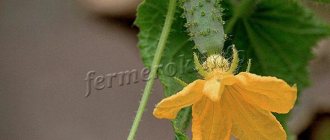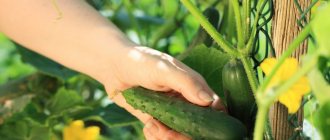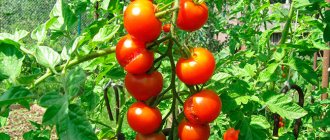Hybrids and varieties of cucumbers that form 3 or more ovaries in one node are called bunch or bouquet. The yield when growing such cucumbers is many times greater, and the fruits themselves have a number of advantages: they are medium-sized, often gherkin-type, crunchy and not bitter. They can set fruit without the participation of pollinators. Another plus is complex disease resistance and a developed root system. Breeders are also working on the taste of cucumbers and the duration of fruiting.
Despite all the listed advantages, one should not think that bunch cucumbers are unpretentious and will not require anything in return. This type of fruiting is a variable genetic trait . If you care for cucumbers somehow, without knowing some of their features, the “tuftiness” will not disappear, but will be greatly reduced. Typically, hybrids of bunched cucumbers are very light-loving (the more light, the more ovaries). Myagkova Marina Aleksandrovna, an agronomist, told us about other rules for growing bunched cucumbers.
- SeDeK tips for growing bunched cucumbers
- How to choose a reliable variety of bunch cucumbers
- 3 reasons why you should definitely try growing bunched cucumbers
- 8 Secrets of growing bunched cucumbers
- Forming lashes of bunched cucumbers in the traditional way
- Formation of cucumber hybrids with good branching
- The best bunched cucumber hybrids from SeDeK
- Promising varieties of bunched cucumbers for planting at the dacha
SeDeK tips for growing bunched cucumbers
How to choose a reliable variety of bunch cucumbers
When choosing a hybrid, pay attention to the degree of branching - from weakly to highly branched. The higher this indicator, the more productive the hybrid; we can say that one plant replaces a whole bed of ordinary cucumbers. The fruits are beautiful, medium in size and not bitter. Among bunch cucumbers, there are gherkin varieties that have the distinctive ability to slow down the growth of greens - this prevents them from overgrowing. It is typical that the more ovaries on one node, the more gherkins they make. Another plus is higher early maturity: the harvest is obtained within 1.5 months after plant germination.
Timing and technology of planting cucumbers
Agricultural technology for growing bunched cucumbers, as well as regular ones, involves the use of seedling and non-seedling methods. The regions of the country differ greatly in climate; the timing of planting crops differs for them by several weeks - you need to focus on local weather conditions. The crop is hypersensitive to cold: good seed germination is possible only at air temperatures above 12-14°C. The soil should warm up by 10°C at a depth of 10 cm. Therefore, in the north of the country it is recommended to grow early varieties, such as bunched ones, through seedlings. This speeds up the production of the first fruits by about two weeks.
Hybrid seeds do not require pre-sowing treatment. For seedlings, they are sown in small containers about 10 cm high. The nutrient mixture is prepared from one part of small sawdust and 2 parts of humus and peat. For 10 liters of this mixture add 2 tbsp. spoons of wood ash and 1.5 tbsp. spoons of nitrophoska. In the phase of 2 true leaves, seedlings are fed with nitroammophos or nitrophoska (3 teaspoons per 3 liters of warm water).
It is better not to disturb the root system of bunched cucumbers, like ordinary cucumbers, so picking the seedlings is not necessary. It can be transplanted to permanent beds after a month.
In greenhouses and greenhouses
In protected ground, it is better to grow self-pollinating varieties of bunched cucumbers, so as not to depend on the rare arrival of pollinating insects into greenhouses.
Planting bunched hybrids in greenhouses can also be done using seedlings and without seedlings:
- with direct sowing under cover, mass shoots can appear after 4-5 days. It is important to provide them with access to fresh air to prevent overheating and death;
- The seedlings are transferred to the greenhouse in the phase of 3-4 true leaves. Before sowing, fertilize the soil with conventional complex mineral fertilizers. Water every other day or as the soil dries out.
Gartering and shaping should begin a few days after planting the seedlings.
In the open ground
A week before planting, the finished bed is fertilized with compost with the addition of complex mineral fertilizer. Since bundle hybrids do not like crowding, they are planted at a distance of at least 40-50 cm, and highly branched varieties are even less common. They install a trellis (its use allows you to increase the yield of bunched cucumbers several times) and also begin to form bushes in a timely manner in order to achieve maximum yield.
Planting seeds is similar to planting in greenhouses, but you will have to wait a little longer for germination. Seeds are planted in the beds in one or two rows.
Offer from the SeDeK store
Cucumber seeds Gerda F1Buy Cucumber seeds Gift of the East F1Buy Cucumber seeds Paganini's Fingers F1Buy Cucumber seeds Russian style F1Buy Cucumber seeds Champion SeDeK F1Buy Cucumber seeds Primadonna F1Buy Cucumber seeds Openwork F1Buy Cucumber seeds Pupa F1Buy cucumber seeds Prestige F1Buy
3 reasons why you should definitely try growing bunched cucumbers
Cucumber hybrids with a bouquet type of flowering have obvious advantages:
1. Stable high yield. The peculiarity of such plants is that the flowers in the inflorescence (bunch) do not open simultaneously, but alternately: 1-2 per day or every other day. The plant has “spare” ovaries in case of death of part of the ovaries due to unfavorable conditions - some ovaries will die, others will begin to grow, and the gardener will not be left without a harvest.
2. Cucumbers do not outgrow. The more cucumbers growing in one bosom, the slower each of them grows. This is why bunch cucumbers do not have time to turn into “overgrown” ones. This property is especially valuable for gardeners who come to the dacha only on weekends and at the same time want to receive “calibrated” raw materials for winter harvesting.
3. Many fruits ripen at the same time. At the height of fruiting, when the filling of ovaries occurs in many nodes at once, the plant may have 12-15 fruits suitable for harvesting. Again, this is a real find for summer residents. You can come once a week and reap a good harvest.
Forming lashes of bunched cucumbers in the traditional way
The first three or four knots are blinding. Starting from the fifth, all emerging side shoots are removed, leaving each node with an ovary (the future “bundle”) and a leaf. At the top nodes, leave 2–3 side shoots and pinch them into 2–3 leaves. To prevent the shoots from being shaded, remove the leaf from the main stem under the trellis. Next, the stem is wrapped around the trellis and pinched.
The plant is formed into one stem: at each node there is a leaf and a “bunch” of cucumbers, and only in the upper part there remain side shoots of 2 bunches and 2–3 leaves.
Necessary care
Despite the fact that bunching is a genetic factor, the number of ovaries depends largely on cultivation conditions and plant health. Excess nitrogen in the soil, lack of watering, severe overheating, and too rapid growth of the main stem reduce the number of green plants formed.
Feeding
Bunch cucumbers need feeding more often than regular varieties. Complex mineral fertilizer is added during watering weekly in small doses - 10–20 g per square meter of plantings. When the number of ovaries decreases, feeding is reduced.
See also Wilting of cucumbers in greenhouses and open ground: how to treat and how to treat
Watering
Water bunched cucumbers once every two days or daily if it’s hot. Focus on the top layer of soil; it should remain moist, but not overly flooded with water. On waterlogged soils, cucumbers grow green foliage to the detriment of flowering.
It is better to water in the evenings, when the sun has set, or in the early hours, so as not to burn the leaves through the “lenses” of the drops remaining on them. The water should not be cold.
Shaping and garter
Plants of bunch varieties begin to form a week after planting cucumber seedlings, when 8-9 leaf blades appear. In bunched hybrids, lateral shoots appear in the leaf axils along the entire length of the main stem. If left, thickening will negatively affect the number of ovaries per node, as well as the growth of fruits on the main stem. Therefore, they are usually formed into one stem. This increases productivity, saves labor costs, and improves the taste of the fruit.
Working technology:
- the lower 4-6 nodes blind in advance, even before the start of flowering, pluck out the buds of lateral shoots and female ovaries from the leaf axils. This will allow the plants to grow faster and develop powerful leaves. Those seedlings that were lagging behind in development will take root well;
- Along the main stem, the lateral shoots are then removed until the beginning of the trellis wire. They do this while they are small (they have not outgrown 3-5 cm). Leave 2-3 shoots on the main stem under the trellis, before pinching them into 2 leaves;
- when the top of the shoot grows to the top of the trellis, it is wrapped around the wire a couple of times;
- if it reaches a neighboring plant, it needs to be pinched.
In this way, nutrients are redistributed in a bunched plant and the filling of greens on the main stem is stimulated (it should be taken into account that the share of the harvest from it in bunched hybrids is usually no less than 60%). Removing side shoots at the bottom and middle part of the main vine promotes good aeration and illumination of the lower leaf blades.
If you carry out the formation of bunch varieties in the manner described above, fruiting will occur a couple of days later, but within a week the yield will be 2-3 times higher than without it.
Prevention from insects and diseases
Fortunately, most varieties of bunch hybrids have stable immunity to the main diseases of the crop, and their early ripening period guarantees that harmful insects, the main period of development of which occurs at a later date, will not cause them damage. However, to further reduce the risk of disease, it is worth taking appropriate preventive measures:
- observe crop rotation (when the same crop is cultivated annually, certain types of pests and pathogens accumulate in the soil);
- carefully remove weeds not only inside greenhouses, but also around them, since many pests find refuge there;
- remove old, dried fruits and flowers from the ovaries;
- maintain the healthy state of plants by timely watering and fertilizing;
- regularly inspect them, especially along windows and paths, for timely identification of pests.
It is very important to maintain temperature and humidity conditions if bunch varieties are grown in a greenhouse. Despite the fact that they love warmth and moist soil, overheating reduces the number of ovaries formed, and constant dampness is fraught with the development of putrefactive processes on the roots.
Formation of cucumber hybrids with good branching
At the bottom of the stem, 3–4 nodes are blinding. In the next 3 nodes, the ovaries are left, but the side shoots are removed. Next, ovaries and side shoots are left in 3 nodes, which are pinched onto one leaf with the ovary. In the next nodes to the trellis, the shoots are pinched into 2 leaves with ovaries. Under the trellis itself, that is, in the two upper nodes, the side shoots are sometimes pinched into 3 leaves with ovaries, if they do not shade the lower ones.
The main stem, as in the first option, is wrapped around the trellis 1-2 times, secured and pinched.
Cucumbers with tufted ovary - what kind of variety is this?
They are called not only bunch, but also bouquet. Bundle varieties of cucumbers differ from other varieties in the unusual placement of ovaries and their number. One node with ovaries can form up to two or three fruitful bunches. When flowering, one flower is usually formed, but bouquet cucumbers can have several at once. When ripe, the fruits form a bunch, as they grow from 1 node.
The yield of such varieties is 4-5 times higher than that of ordinary ones. Thanks to their hybridity, cucumbers rarely get sick and do not require careful care. They can be planted in polycarbonate greenhouses or in open ground.
Bundle cucumbers are unusual in that their fruits grow from a single node, forming clusters.
The best bunched cucumber hybrids from SeDeK
F1 Openwork . Mid-early (45-48 days) hybrid for open and protected ground. The plant is powerful, medium-branched, 1-3 fruits are formed in each node. Zelentsy are short, 8-11 cm long, cylindrical, dark green, with a frequent arrangement of large tubercles and white pubescence, dense, crispy, aromatic. The hybrid is resistant to cucumber mosaic virus, powdery mildew, stress-resistant, abundant and long-term fruiting, transportable. The purpose is universal. Productivity in film greenhouses is 16-18 kg/m2.
F1 Gerda. Mid-early (43–47 days) bee-pollinated hybrid with partial parthenocarpy, predominantly female type of flowering. The plant is indeterminate, strongly climbing, with a middle leaf, with 1–3 ovaries per node. During the period of mass fruiting, up to 20 fruits are simultaneously formed on one plant. Gherkins are cylindrical, smooth, green with short light stripes, sparsely tuberculate, with white pubescence, 9-12 cm long, weighing 70–110 g, strong, crispy, do not overgrow or turn yellow, do not form voids and are not deformed. Ideal for canning and pickling. The hybrid is resistant to olive spot, cucumber mosaic virus, true and downy mildew. Productivity in open ground is 45–50 t/ha. Productivity in film shelters is 14-15 kg/m2.
F1 Pupa . Early ripening (40-45 days) parthenocarpic hybrid for open ground and film shelters. The plant is vigorous, climbing, with bouquet fruit formation, 3-5 ovaries are formed in each node. Zelentsy are cylindrical, dark green, with short lightened stripes, large and often tuberculate, with white pubescence, 9-10 cm long, weighing 80-100 g, crispy, sweet. The hybrid is resistant to cladosporiosis, cucumber mosaic, powdery mildew and downy mildew, the greens are even and have high commercial qualities. Transportable. Intended for fresh consumption, pickling and salting. Productivity in film greenhouses is 12-15 kg/m2.
F1 Prestige . Early ripening (42–45 days) hybrid for open ground and film shelters. The plant is medium-sized, medium-climbing, female-flowering with a bunched arrangement of ovaries (3-4 per node). Zelentsy are short, cylindrical, large-tubercular, dark green with short stripes, with white pubescence, 8–10 cm long, weighing 65–90 g, excellent taste, retain their presentation for a long time and do not form voids during canning. The hybrid is resistant to diseases and stress, especially to temperature changes and low light levels, and has a long fruiting period. Transportable. Purpose: canning. Productivity in film greenhouses is 22–25 kg/m2.
F1 Gift of the East. Mid-season (50-55 days) parthenocarpic hybrid for film greenhouses. The plant is medium-sized, weakly climbing, with few leaves, with bunched fruit formation, up to 4-5 ovaries are formed in each node. The fruits are short-cylindrical, smooth, green with slight pubescence, 8-10 cm long, 4 cm in diameter, weighing 85 g, aromatic, sweet, crispy. The hybrid is resistant to powdery mildew, fruiting is abundant and long-lasting. Has high quality fruits. Suitable for large-scale production. Intended for fresh consumption and pickling. Productivity in film greenhouses is 10-15 kg/m2.
F1 Paganini's fingers. Early ripening (43-45 days) parthenocarpic hybrid for open ground and film shelters. The plant is vigorous and climbing. Three ovaries are formed per node. Zelentsy are dark green, cylindrical, large-tubercular, with an average arrangement of tubercles, 12-14 cm long, dense, juicy, crispy, aromatic. Resistant to cladosporiosis, powdery mildew, shade-tolerant. Productivity 10-12 kg/m2.
F1 Russian style . Early ripening (45–48 days) hybrid for open ground and spring-summer film shelters. The plant is medium-sized, medium-branched, with a female type of flowering and bunched fruit formation, in each node 3–4 ovaries are formed on the main stem, and up to 6–8 on the side shoots. The greens are cylindrical, finely tuberous, dark green with short light stripes, white-thorned, with white pubescence, 10–12 cm long, weighing 80–110 g, crispy, aromatic, without bitterness. The hybrid is resistant to root rot, powdery mildew, and tolerant to downy mildew. Combines early ripening, friendly yield and high technological qualities. Intended for fresh consumption and canning. Productivity in film greenhouses is 18–20 kg/m2.
F1 Champion SeDeK . Mid-season (45–55 days) hybrid for open ground and film shelters. The plant is medium-sized, weakly climbing, with a female type of flowering and bunched (2-4) formation of ovaries. The greens are cylindrical, coarsely tuberous, smooth, dark green with short stripes, 10–12 cm long, weighing 75–110 g, dense, crispy. During the period of mass fruiting, it forms 30–40 fruits simultaneously. The hybrid is resistant to diseases and stress, has a consistently high yield even in unfavorable conditions, a long fruiting period, and excellent technological qualities of gherkins. The purpose is universal. Productivity in film greenhouses is 22–25 kg/m2.
F1 Diva . Early ripening (35–45 days) hybrid for open ground and film shelters. The plant is vigorous, highly climbing, with a female type of flowering and bunched formation of ovaries, 3–4 (up to 6–9) per node. Zelentsy are short, cylindrical, finely tuberculate, dark green, with white pubescence, 10–12 cm long, weighing 85–110 g, dense, without bitterness. The hybrid has complex resistance to diseases and temperature changes, abundant and friendly yield with a long fruiting period, is suitable for transportation, and retains its presentation for a long time. During processing, no voids are formed in the greens and the color is preserved. Universal purpose. Productivity in film greenhouses is 25–28 kg/m2.
![Tinkoff (Debit card) [CPS] RU](https://adzumi-sushi.ru/wp-content/uploads/tinkoff-debetovaya-karta-cps-ru41-330x140.jpg)
